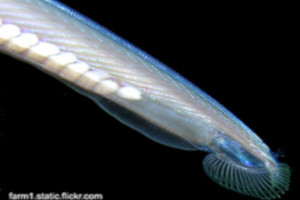Generalities
One of the major issues in evolution of development is the origin of vertebrates. It is now generally accepted that vertebrates are descended from an invertebrate chordal ancestor, and several models within the living representatives of chordates are currently being used to answer this question. the Mediterranean amphioxus (lancelet) Branchiostoma lanceolatum is one of the models used to answer the question of vertebrate emergence.
It is now possible to obtain fertilization in laboratory every day from April to July, thus allowing the modification of gene expression by injecting mRNA into the egg. In addition, the complete genome sequence is known and published as well as the numerous epigenetic marks such as those from Chip-seq, ATAC-seq, SAGE, Methylome, or 4C-seq.
Reproduction
Branchiostoma lanceolatum has two separate sexes and an external mode of fertilization. The natural egg-laying period in the Mediterranean extends from mid-May to the end of July. In captivity, lancelets collected during the natural egg-laying period can lay eggs randomly.
A controlled egg-laying induction method has been developed, allowing eggs and sperm to be obtained separately every day between March and September. This method involves a change in temperature (from 18°C to 23°C) for 36 hours. After 36 hours, egg laying occurs naturally in cups with the males and females separated, which allows manual and synchronous fertilisation to take place.
It is then possible to cultivate the embryos and study the early stages of lancelet development. The complete life cycle in captivity has also been developed for Mediterranean B. lanceolatum. Thus an embryo needs three years to develop into an adult. However, full gonadal development of adults in captivity has not yet been achieved.
Tools
- Possibility to induce in-vitro fertilization every day for 4-5 months a year
- Modification of gene expression by injection of mRNA into the unfertilized egg
- Transcriptome of each stage of development as well as different functional conditions
- Immunofluorescence or HIS gene expression profiles
- Functional modification of different signalling pathways by pharmacological treatments
Databases
link to the full Genome Browser, annotation, transcriptome and proteome of B. lanceolatum: https://amphiencode.github.io/Data/
cDNA clone resource for B. floridae : http://amphioxus.icob.sinica.edu.tw/
Infrastructures
- Groupe évolution et développement des chordés UMR7232 SU-CNRS
- http://biom.obs-banyuls.fr/fr/equipe_evolution_et_developpement_des_chordes.html
- Banyuls-sur-mer
- Groupe Evolution des voies de signalisation intercellulaire durant le développement (EvoInSiDe) UMR7009 SU-CNRS
- http://lbdv.obs-vlfr.fr/fr/recherche/equipes_de_recherche/evolution-des-voies-de-signalisation-intercellulaire-durant-le-developpement.html
- Villefranche-sur-mer
Experts
- Hector ESCRIVA
- hector.escriva@obs-banyuls.fr
- Groupe Evolution et Développement des Chordes, Observatoire Océanologique de Banyuls-sur-Mer
Bibliography
- Articles
Fuentes M, Schubert M, Dalfo D, Candiani S, Benito E, Gardenyes J, et al. “Preliminary observations on the spawning conditions of the European amphioxus (Branchiostoma lanceolatum) in captivity.”
J Exp Zoolog Part B Mol Dev Evol. 2004;302(4):384-91.
Bertrand S, Escriva H. “Evolutionary crossroads in developmental biology: amphioxus.”
Development. 2011;138(22):4819-30.
Marletaz F, Firbas PN, Maeso I, Tena JJ, Bogdanovic O, Perry M, et al. “Amphioxus functional genomics and the origins of vertebrate gene regulation.”
Nature. 2018;564(7734):64-70. Epub 2018/11/23. doi: 10.1038/s41586-018-0734-6.
Escriva H. “My Favorite Animal, Amphioxus: Unparalleled for Studying Early Vertebrate Evolution.”
Bioessays. 2018:e1800130. Epub 2018/10/18
Acemel RD, Tena JJ, Irastorza-Azcarate I, Marletaz F, Gomez-Marin C, de la Calle-Mustienes E, et al. “A single three-dimensional chromatin compartment in amphioxus indicates a stepwise evolution of vertebrate Hox bimodal regulation.”
Nat Genet. 2016;48(3):336-41.
